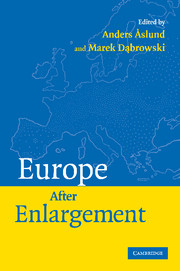Book contents
- Frontmatter
- Contents
- List of Charts, Tables, and Boxes
- Contributors
- Acknowledgments
- Introduction
- 1 Has Europe Lost Its Heart?
- 2 Economic Implications of the Social Provisions of the Stalled EU Constitution
- 3 Fiscal Policy and Fiscal Rules in the European Union
- 4 Design and Implementation of the Stability and Growth Pact: The Perspective of New Member States
- 5 Perspectives on the Lisbon Strategy: How to Increase European Competitiveness
- 6 Is Europe Reforming? Evidence from Cross-Country Structural Indicators
- 7 Recovery Growth as a Stage of Post-Socialist Transition
- 8 Comparative Oligarchy: Russia, Ukraine, and the United States
- 9 The Economic Rationale of the “European Neighbourhood Policy”
- 10 Economic Integration of Eurasia: Opportunities and Challenges of Global Significance
- Index
- References
7 - Recovery Growth as a Stage of Post-Socialist Transition
Published online by Cambridge University Press: 04 December 2009
- Frontmatter
- Contents
- List of Charts, Tables, and Boxes
- Contributors
- Acknowledgments
- Introduction
- 1 Has Europe Lost Its Heart?
- 2 Economic Implications of the Social Provisions of the Stalled EU Constitution
- 3 Fiscal Policy and Fiscal Rules in the European Union
- 4 Design and Implementation of the Stability and Growth Pact: The Perspective of New Member States
- 5 Perspectives on the Lisbon Strategy: How to Increase European Competitiveness
- 6 Is Europe Reforming? Evidence from Cross-Country Structural Indicators
- 7 Recovery Growth as a Stage of Post-Socialist Transition
- 8 Comparative Oligarchy: Russia, Ukraine, and the United States
- 9 The Economic Rationale of the “European Neighbourhood Policy”
- 10 Economic Integration of Eurasia: Opportunities and Challenges of Global Significance
- Index
- References
Summary
The complexity of post-socialist transition was unprecedented. Initially, no one could accurately predict its pace or foresee how soon and to what extent it would be accomplished.
For example, when Solidarity's victory in the 1989 elections opened the “window of opportunity” for Polish reformers, it was impossible to assess the extent of Poland's problems and foresee the difficulties that would arise as the society and the economy adapted to market conditions. But today the stage of transformational recession, as well as the discussion about its causes and consequences, belongs to the past. Although major difficulties still have to be overcome, the economies of post-socialist countries largely display stable GDP growth and effective market mechanisms.
Transformational recession can be explained rather simply. The dismantling of the socialist economic structure revealed a sad circumstance: a substantial part of the economic activities carried out under socialism would never be needed in a market economy or democracy. The redistribution of resources concentrated in those activities cannot occur overnight. Processes that occurred at this stage of post-socialist recession were reminiscent of what Joseph Schumpeter (1950) described as “creative destruction,” but they occurred on a scale unprecedented for market economies. It is vital to understand that both post-socialist recession (the adaptive decrease in production) and the subsequent recovery are part and parcel of a single process, whose essence is the structural rebuilding of the economy.
- Type
- Chapter
- Information
- Europe after Enlargement , pp. 127 - 142Publisher: Cambridge University PressPrint publication year: 2007



